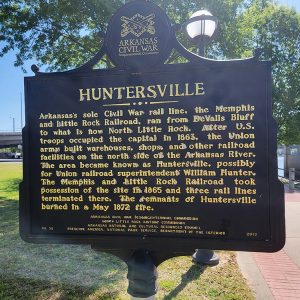calsfoundation@cals.org
Skirmish at Huntersville
| Location: | Pulaski County |
| Campaign: | None |
| Date: | July 8, 1864 |
| Principal Commanders: | Unknown (US); Unknown (CS) |
| Forces Engaged: | Tenth Illinois Cavalry (US); Unknown (CS) |
| Estimated Casualties: | None (US); 4 killed or wounded, 1 captured (CS) |
| Result: | Union victory |
A brief and unimportant clash between small units, this skirmish is a great example of the majority of fighting that took place in the state in the latter half of 1864 and afterward.
With the conclusion of the Camden Expedition in the spring of 1864, Union forces under the command of Major General Frederick Steele returned to the Little Rock (Pulaski County) area. Camping in numerous forts and other fortifications constructed in the area, the Federal troops rarely launched major offensive operations in Arkansas for the remainder of the war. However, in an effort to keep Confederate forces off balance, Federals did patrol regularly. These patrols engaged enemy forces when they encountered them and prevented the Confederates from launching major attacks on Little Rock or other Union outposts around the state.
The Tenth Illinois Cavalry participated in the Camden Expedition before returning with the remainder of the army to central Arkansas. Posted to Huntersville, which is now part of North Little Rock (Pulaski County), the regiment regularly patrolled the area north of the Arkansas River. Little Rock was connected to DeValls Bluff (Prairie County) by an important railroad, and the unit worked to keep the enemy from cutting this important connection. Supplies ascended the White River to DeValls Bluff, where they were loaded on rail cars for transport to Little Rock. By disrupting rail traffic, Confederate forces could starve the Union troops in the capital city.
In an effort to prevent this disruption, Colonel James Stuart of the Tenth Illinois sent patrols to scout the areas north of the river. In mid-July, a party of twenty enlisted men and one lieutenant departed Huntersville to participate in one such scout. On July 7, the party met and engaged a small unit of Confederate troops. In the brief engagement that followed, the Federals captured one enemy soldier and killed or wounded four more while not suffering any casualties of their own. The remaining Confederates escaped, and the Union troops did not pursue. Returning to Huntersville the next evening, the Federals reported their successful scout to Stuart, who in turn informed authorities across the river in Little Rock.
The later war in Arkansas consisted mostly of clashes like this one—involving small units bumping into one another.
For additional information:
The War of the Rebellion: A Compilation of the Official Records of the Union and Confederate Armies. Series 1, Vol. 41. Washington DC: Government Printing Office, 1889.
David Sesser
Henderson State University








Comments
No comments on this entry yet.